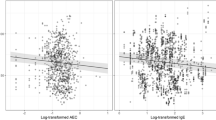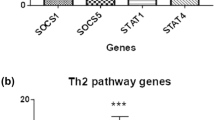Abstract
Purpose
Cystic Fibrosis (CF) is a multi-organ genetic disorder and Transforming Growth Factor (TGF-β1) is a modifier gene which modulates lung pathology in CF. There is great phenotypic variability among CF patients who even have similar genotype. The aim of the present study was to associate the serum levels of TGF-β1 with several clinical phenotypes of CF.
Methods
The diagnosed cases of CF were recruited and the blood sample was withdrawn at different time points: during exacerbation (n = 26), non-exacerbation (n = 9) and after antibiotic therapy (n = 11). The concentration of the total TGF-β1 in serum was measured with commercial ELISA kit. The ΔF508 mutation was assessed by the Amplification Refractory Mutation System (ARMS-PCR).
Results
The levels of TGF-β1 were increased in exacerbation phase (119.89 ± 29.64 ng/mL), infection with P. aeruginosa (121.8 ± 28.83 ng/mL) and in subjects with ΔF508 mutation (139.2 ± 19.59 ng/mL). The levels of TGF-β1 in CF patients with Allergic Bronchopulmonary Aspergillosis (ABPA) (109.97 ± 27.71 ng/mL) were decreased as compared to CF patients without ABPA (123.55 ± 30.20 ng/mL). It was observed that the serum levels of TGF-β1 were decreased significantly after antibiotic therapy (p < 0.05).
Conclusions
The present study has determined that the serum levels of TGF-β1 vary with the type of infections, ΔF508 CFTR mutation, presence of ABPA and response to therapy.






Similar content being viewed by others

References
Boucher RC (2004) New concepts of the pathogenesis of cystic fibrosis lung disease. Eur Respir J 23(1):146–158
Kerem E, Corey M, Kerem B et al (1990) The relation between genotype and phenotype in cystic fibrosis—analysis of the most common mutation (ΔF508). N Engl J Med 323(22):1517–1522
Drumm ML, Konstan MW, Schluchter MD, Handler A, Pace R, Zou F et al (2005) Genetic modifiers of lung disease in cystic fibrosis. N Engl J Med 353(14):1443–1453
Bremer LA, Blackman SM, Vanscoy LL, McDougal KE, Bowers A, Naughton KM et al (2008) Interaction between a novel TGFB1 haplotype and CFTR genotype is associated with improved lung function in cystic fibrosis. Hum Mol Genet 17(14):2228–2237
Magnan A, Frachon I, Rain B, Peuchmaur M, Monti G, Lenot B et al (1994) Transforming growth factor β in normal human lung: preferential location in bronchial epithelial cells. Thorax 49(8):789–792
Flanders KC (2004) Smad3 as a mediator of the fibrotic response. Int J Exp Pathol 85(2):47–64
Arkwright PD, Laurie S, Super M, Pravica V, Schwarz MJ, Webb AK et al (2000) TGF-beta(1) genotype and accelerated decline in lung function of patients with cystic fibrosis. Thorax 55(6):459–462
Haston CK, Hudson TJ (2005) Finding genetic modifiers of cystic fibrosis. N Engl J Med 353(14):1509–1511
Harris WT, Muhlebach MS, Oster RA et al (2009) Transforming growth factor-beta(1) inbronchoalveolar lavage fluid from children with cystic fibrosis. Pediatr Pulmonol 44(11):1057–1064
Harris WT, Muhlebach MS, Oster RA, Knowles MR, Clancy JP, Noah TL (2011) Plasma TGF-β(1) in pediatric cystic fibrosis: potential biomarker of lung disease and response to therapy. Pediatric Pulmonol 46(7):688–695
Schwarz KB, Rosensweig J, Sharma S, Jones L, Durant M, Potter C, Narkewicz MR (2003) Plasma markers of platelet activation in cystic fibrosis liver and lung disease. J Pediatric Gastroenterol Nutr 37(2):187–191
Snodgrass SM, Cihil KM, Cornuet PK, Myerburg MM, Swiatecka-Urban A (2013) Tgf-b1 inhibits Cftr biogenesis and prevents functional rescue of ΔF508-Cftr in primary differentiated human bronchial epithelial cells. PLoS ONE 8(5):e63167
Sun H et al (2014) Tgf-beta downregulation of distinct chloride channels in cystic fibrosis-affected epithelia. PLoS ONE 9:e106842
Collaco JM, Cutting GR (2008) Update on gene modifiers in cysticfibrosis. Curr Opin Pulm Med 14:559–566
Bilton D, Canny G, Conway S et al (2011) Pulmonary exacerbation: towards a definition for use in clinical trials. Report from the EuroCareCF Working Group on outcome parameters in clinical trials. J Cyst Fibros 10:S79–S81
Stevens DA, Moss RB, Kurup VP, Knutsen AP, Greenberger P, Judson MA et al (2003) Allergic bronchopulmonary aspergillosis in cystic fibrosis—state of the art: cystic fibrosis foundation consensus conference. Clin Infect Dis 37(3):S225–S264
Ferrie RM, Schwarz MJ, Robertson NH, (1992) Development, multiplexing and application of ARMS tests for common mutations in the CFTR gene. Am J Hum Genet 5:149–155
Eickmeier O, Boom L, Schreiner F, Lentze MJ, NGampolo D, Schubert R, et al (2013) Transforming growth factor β1 genotypes in relation to TGFβ1, interleukin-8, and tumor necrosis factor alpha in induced sputum and blood in cystic fibrosis. Med Inflamm 2013:913135
Corvol HBP, Brouard J, Knauer N, Chadelat K, Henrion-Caude A, Flamant C et al (2008) Genetic variations in inflammatory mediators influence lung disease progression in cystic fibrosis. Pediatr Pulmonol 43(12):1224–1232
Dawson KP, Frossard PM, Al-Awar B (2001) Disease severity associated with cysticfibrosis mutations deltaF508 and S549R(T–%3eG). East Mediterr Health J 7(6):975–980
Mitash N, Mu F, Donovan JE, Myerburg MM, Ranganathan S, Greene CM, Swiatecka-Urban A (2019) Transforming growth factor-β1 selectively recruits microRNAto the RNA-induced silencing complex and degrades CFTR mRNA under permissive conditions in human bronchial epithelial cells. Int J Mol Sci 20(19):4933
Knutsen AP et al (2019) T cell cytokine synthesis in cystic fibrosis patients with allergic bronchopulmonary aspergillosis. J Allergy Clin Immunol 113(2):S278
Maloney JP, Narasimhan J, Biller J (2019) Decreased TGF-β1 and VEGF release in cystic fibrosis platelets: further evidence for platelet defects in cystic fibrosis. Lung 194(5):791–798
Acknowledgement
Indian Council of Medical Research, New Delhi.
Funding
The study was supported by Indian Council of Medical Research, New Delhi through grant no: ICMR JRF No. 3/1/3/JRF-2012/HRD-08 (10835).
Author information
Authors and Affiliations
Contributions
SS was involved in conceptualizing the research proposal, performed all experimental procedures and wrote the manuscript. AC was involved in genetic analysis of CFTR mutation and wrote the manuscript. JK and RP provided the laboratory facilities and helped in analysing the data. MS (Meenu Singh) was responsible for patient recruitment, obtaining informed consent and data analysis. MS (Manvi Singh) was involved in patient recruitment.
Corresponding author
Ethics declarations
Conflict of interest
The authors declare that they have no conflict of interest.
Additional information
Publisher's Note
Springer Nature remains neutral with regard to jurisdictional claims in published maps and institutional affiliations.
Rights and permissions
About this article
Cite this article
Sagwal, S., Chauhan, A., Kaur, J. et al. Association of Serum TGF-β1 Levels with Different Clinical Phenotypes of Cystic Fibrosis Exacerbation. Lung 198, 377–383 (2020). https://doi.org/10.1007/s00408-020-00320-x
Received:
Accepted:
Published:
Issue Date:
DOI: https://doi.org/10.1007/s00408-020-00320-x



